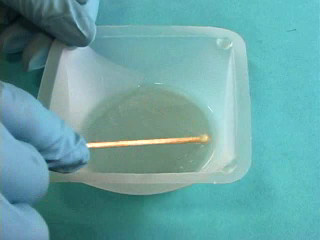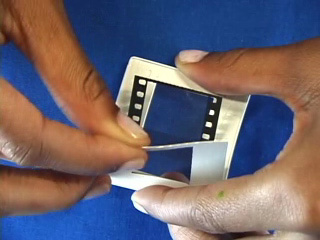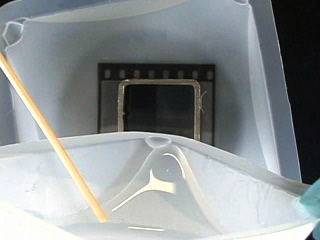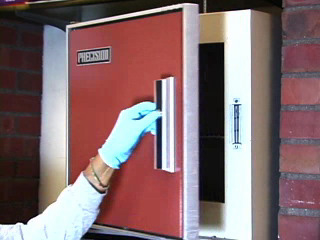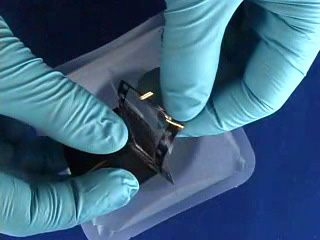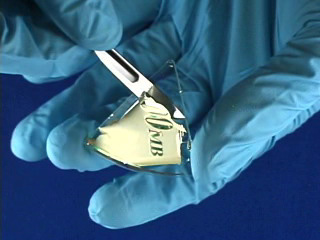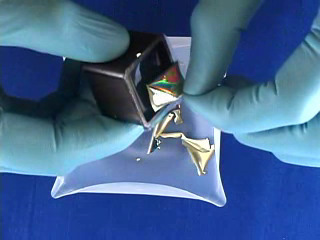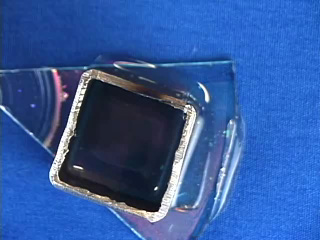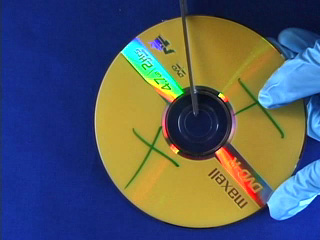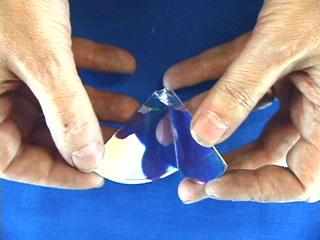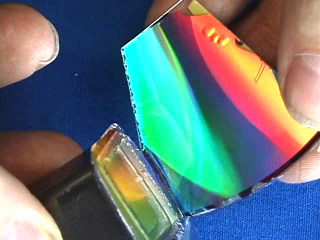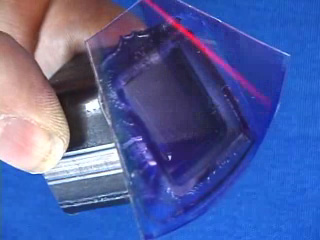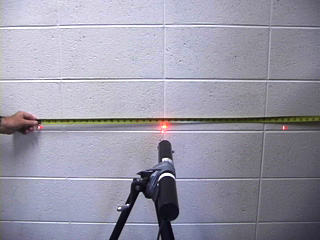
Replication of Surface Structures with Polydimethylsiloxane (PDMS Soft Lithography)
The procedure shown here was modified by T. Armbrister, G. Grigoriev, K. Hansgen, Z. Hess, T. Ksander, X. Ma, J. Reid, A. Rini, and S. Rudisill from D. J. Campbell, K. J. Beckman, C. E. Calderon, P. W. Doolan, R. M. Ottosen, A. B. Ellis, and G. C. Lisensky, Journal of Chemical Education, 76, 537-541, (1999).
PDMS is cured by an organometallic crosslinking reaction to give an optically transparent polymer with the ability to reproduce surface features. In this experiment the polymer is cured in contact with optical transform slides or the pits on a CD or DVD. How well are the original features copied? Use diffraction of a laser beam to measure the original feature sizes and the sizes of the copied features. Since PDMS is flexible the surface features imprinted into the elastomer can be also be distorted mechanically and their changing spacings monitored by diffraction.
| Procedure | Wear eye protection |
Chemical gloves recommended |
 Never look directly into a laser
or shine a laser at another person. Never look directly into a laser
or shine a laser at another person. |
PDMS monomer can be messy. Cover work surfaces with foil. |
Preparation of PDMS
Dispensing the viscous liquid can be messy. Cover the work surface and the balance with aluminum foil. Wear gloves.Add 4.00 g of Sylgard polymer base to a large weighing boat using a disposable plastic spoon. Add 0.40 g of curing agent using a disposable dropper. Thorough mixing of the PDMS components is essential for good curing. Improper mixing can result in a polymer that is a sticky mess. On the order of 100 strokes with a stir stick are needed to mix the polymer components so that they will yield an adequately cured sample. Bubbles degrade the optical qualities of PDMS. Most bubbles trapped during mixing of the components will eventually rise to the top of the liquid where they may be broken by blowing across the surface.
Optical Transform Slide used as a lithography master
Identify the emulsion side of an optical transform film (the side containing raised arrays). The shiny side of the film will sharply reflect room lights on its smooth surface; the matte emulsion side of the film will give more diffuse reflections. Peel open the white plastic slide mount, pick up the film by its edges, and place the film on an aluminum sheet with the emulsion side facing upward. A transparency master with a gray scale pattern could also be used. Place a piece of square tubing on top of the original pattern. Slowly pour less than half of the PDMS mix into the mold assembly. Minimize use of the stir stick since too many bubbles are created. Let the assembly sit at room temperature for a few minutes so that bubbles incorporated during pouring can rise out of the PDMS. Gentle blowing over the surface may also eliminate bubbles. Bubbles will interfere with the diffraction experiments. The transform slide covered by transparent PDMS should have few bubbles. Place the mold into the oven at 130°C for 20 min or 90°C for 30 min. While the mold is in the oven continue with another portion of this experiment. Eventually remove the mold from the oven and allow it to cool. Gently remove the film. The PDMS cast will be easier to clamp in place if you leave it in the square tubing.Everyone should do an optical transform slide and either a CD or DVD
Recordable CD used as a lithography masterAnother pattern with small features is a CD-R disk. Cut out a section using scissors. Carefully peel off the aluminum foil. You may use either the foil or the polycarbonate support as the lithography master.
Place a piece of square tubing on top of the original pattern. Slowly pour much of the other half of the PDMS mix into the mold assembly. Minimize use of the stir stick since too many bubbles are created. Let the assembly sit at room temperature for a few minutes so that bubbles incorporated during pouring can rise out of the PDMS. Gentle blowing over the surface may also eliminate bubbles. Bubbles will interfere with the diffraction experiments. Place the mold in the oven at 130°C for 20 min or 90°C for 30 min.
While the mold is in the oven continue with another portion of this experiment. Eventually remove the mold from the oven and allow it to cool. Gently remove the foil or the CD portion from the cured PDMS.Recordable DVD used as a lithography master
An alternative pattern with smaller features is a DVD-R disk. Cut out a section using scissors. Carefully peel apart the two polymer layers. You may use either the foil or the polycarbonate support as the lithography master.
Place a piece of square tubing on top of the original pattern. Slowly pour much of the other half of the PDMS mix into the mold assembly. Minimize use of the stir stick since too many bubbles are created. Let the assembly sit at room temperature for a few minutes so that bubbles incorporated during pouring can rise out of the PDMS. Gentle blowing over the surface may also eliminate bubbles. Bubbles will interfere with the diffraction experiments. Place the mold in the oven at 130°C for 20 min or 90°C for 30 min.
While the mold is in the oven continue with another portion of this experiment. Eventually remove the mold from the oven and allow it to cool. Gently remove the foil or the DVD portion from the cured PDMS.Optical diffraction to measure feature sizes
Use the Fraunhofer equation, d sin φn = n λ, to determine the feature spacing, d, of the original surface and its copy by passing a laser with wavelength λ through the sample and measuring the nth diffraction angle, φn. This equation assumes the incident laser beam is perpendicular to the surface and that the beam passes through the sample. It is easy to get the patterns mixed up on the optical transform slide. Be sure to sketch the diffraction pattern as evidence that you are looking at the same features in the copy.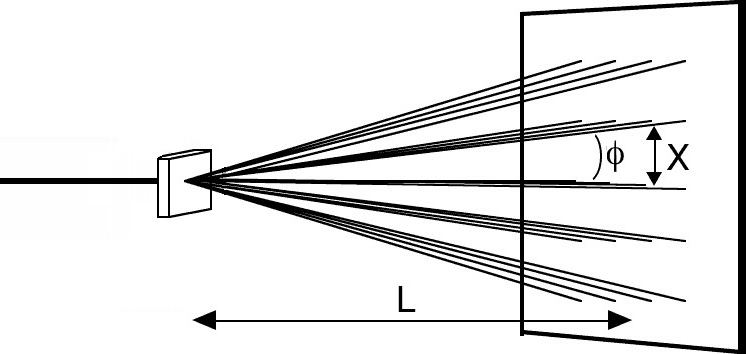
If X is the diffraction spot spacing and L is the PDMS slab-to-screen distance then

If you stretch the PDMS slab, how does the diffraction pattern change?
How well is the track spacing copied for the CD and DVD?
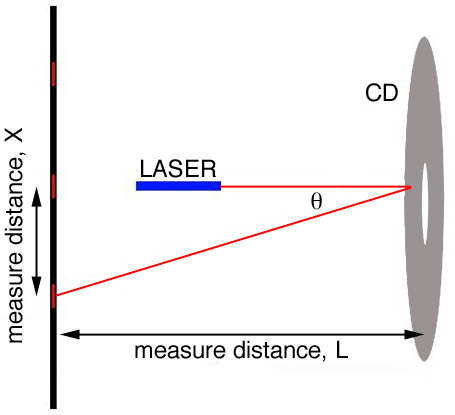
Calculations and Conclusions
1. What is the feature spacing for the original samples? Show your calculations. Report your values in either µm or nm.2. What is the feature spacing for the PDMS copies? Show your calculations.
3. Are the copied features the same size as the original features?
4. Do the feature sizes of the media disks match the known feature sizes for such disks?
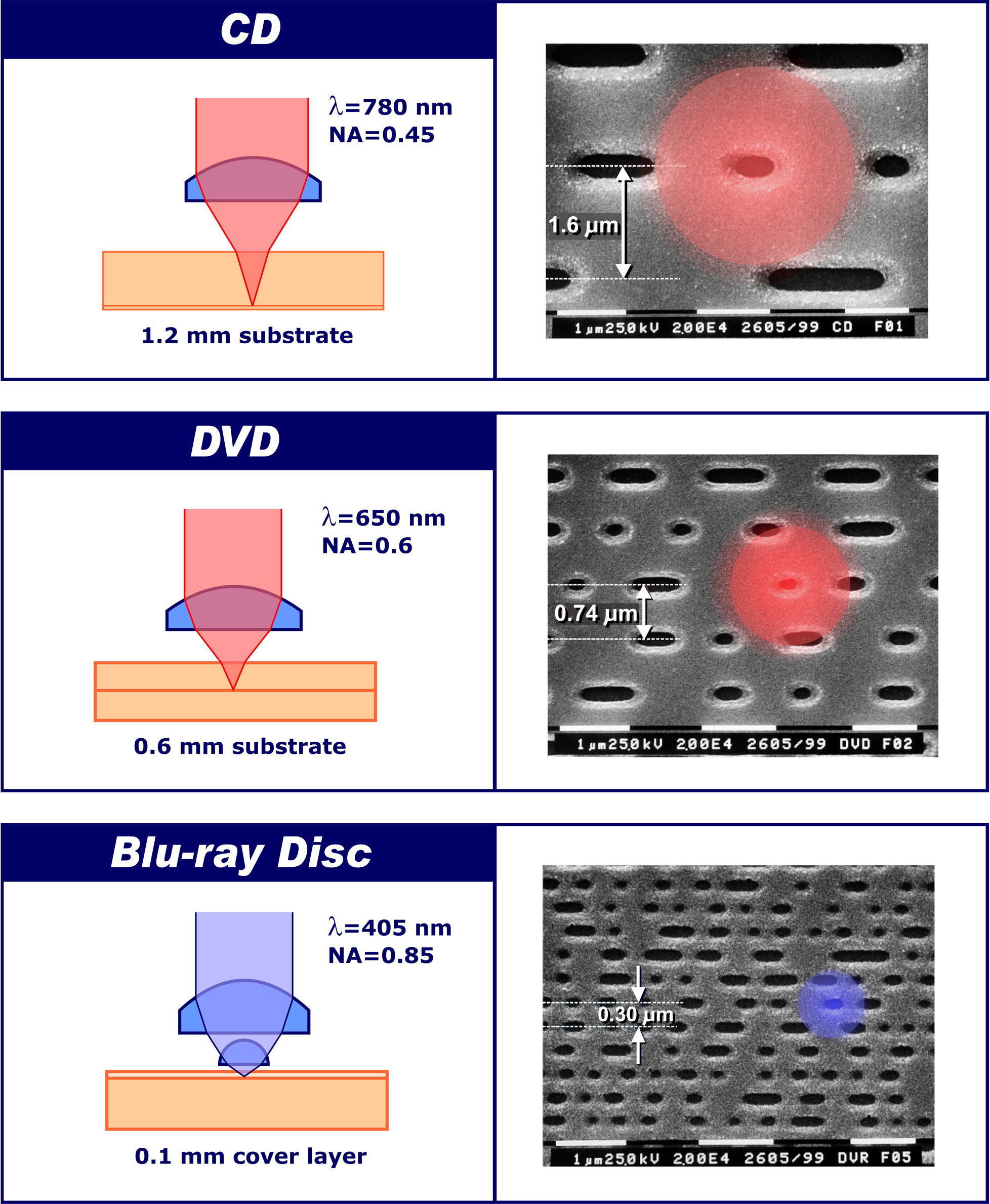
The right column shows scanning electron microscope pictures of different recording media with accompanying laser spots. Photos courtesy of Philips Research. Philips Research Password, 2, January, 2000.
5. When you stretch the PDMS slab, how does the diffraction pattern change?

- PDMS base and curing agent (Dow Corning Sylgard Elastomer 184 Kit, available from Ellsworth Adhesive)
- Aluminum foil
- Disposable gloves
- Weighing boats (100 mL)
- Plastic spoon, dropper, stir sticks
- Sonicator (optional)
- Optical Transform Slides, Institute for Chemical Education, Madison, WI. A lower quality alternative is to use a dithering pattern (from standard computer art programs such as Canvas, Photoshop, or from the box shading function in Microsoft Word) printed onto a transparency.
- Molds cut from 1x1 inch 14 gauge (.083") square metal tubing
- Oven (130 °C)
- CD-R or DVD-R (Sony CD-R and Maxell DVD-R used successfully above) and scissors
- Red laser or laser pointer with known wavelength
- Tape measure

